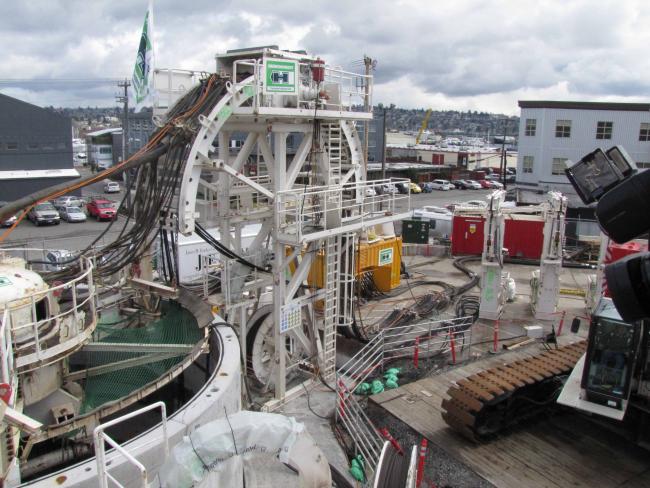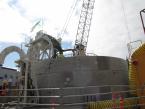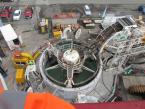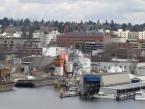Pictures: The Ballard Siphon Replacement Project uses new technology
The VSM: Ballard Siphon projects is using state-of-the-art excavation technology for the first time in North America. King County and its contractor, James W. Fowler Company, will build a 30-foot-diameter, 145-foot-deep launching portal for a tunnel boring machine, without requiring pile driving or ground freezing to stabilize the structure walls. The Vertical Shaft Machine, or VSM, was developed by the European company Herrenknecht. CLICK ON IMAGE TO SEE MORE PHOTOS.
Thu, 04/05/2012
For the past year, The King County Wastewater Treatment Division has been working on the installation of a new 84-inch siphon pipe under Salmon Bay. The new pipe will replace the 77-year-old wooden sewer line, and run between Seattle’s Ballard and Interbay areas to reduce the potential for sewer overflows into the Ship Canal and to meet north Seattle’s wastewater conveyance needs into the next century.
The new siphon will lie 120 feet underground and connect the Ballard Regulator Station to the North Interceptor in Interbay (see map). Wastewater from north Seattle will be conveyed through the new pipe to King County’s West Point wastewater treatment plant in Magnolia.
To complete this project, the county is using sophisticated engineering to make construction a smoother, quieter experience for neighbors of King County’s Ballard Siphon Project.
Using state-of-the-art excavation technology for the first time in North America, King County and its contractor, James W. Fowler Company, will build a 30-foot-diameter, 145-foot-deep launching portal for a tunnel boring machine, without requiring pile driving or ground freezing to stabilize the structure walls. The Vertical Shaft Machine, or VSM, was developed by the European company Herrenknecht.
In addition to being less disruptive than traditional shaft construction, VSM works well in tightly confined city spaces and in areas with difficult soils and high water tables. The machine is also powered by electricity and doesn’t require the continuous operation of noisy diesel generators.
To build the shaft with the VSM, an initial section is excavated and a concrete ring wall is built to support the machine, which is then lifted in with a crane and assembled in place. Winches enable an operator to remotely move the machine up and down, and precast concrete segments are then installed to structurally line the shaft as the VSM continues to excavate.
The shaft is kept full of water during excavation to help balance groundwater levels and to allow the excavated material to be pumped out and sent through separation equipment for disposal. The machine is capable of excavating and lining three to 15 feet each day. A demonstration video is available through the International Tunneling and Underground Space Association website (external link) at http://uww.ita-aites.org/index.php?id=782.
The shaft is scheduled to be completed this June. King County expects to launch a tunnel boring machine in September to build an 10-foot-diameter, 2,000-foot-long tunnel between Shilshole Avenue in Ballard and Commodore Way in Seattle’s Interbay neighborhood.
In service since 1935, King County’s Ballard Siphon carries up to 60 million gallons of wastewater each day underneath the Ship Canal from north Seattle to the West Point Treatment Plant in Magnolia.
King County has budgeted $38 million for the project. A low-interest loan by the Washington State Department of Ecology will provide more than half of the funding.
When complete in 2014, the project will increase system reliability while helping to control combined sewer overflows during heavy rain, helping to protect water quality in the Ship Canal and Salmon Bay.
To learn more about the Ballard Siphon replacement, visit the project website at http://www.kingcounty.gov/environment/wtd/Construction/Seattle/BallardS….





